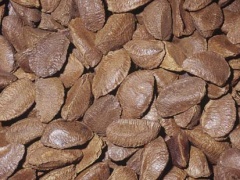Brazil Nuts
| Infobox on Brazil Nuts | |
|---|---|
| Example of Brazil Nuts |  |
| Facts | |
| Origin | - |
| Stowage factor (in m3/t) | 2,69 (bags) |
| Humidity / moisture | 3 - 8% |
| Ventilation | See text |
| Risk factors | See text |
Brazil Nuts
Description
Brazil nuts are the large, elongate, three-sided, oily seeds of the South American brazil nut tree. Because of their flavor, they are also known as the butternut or cream nut.
Brazil nuts are 18% protein, 13% carbohydrates, and 69% fat by weight, and 91% of their calories come from fat. The fat breakdown is roughly 25% saturated, 41% monounsaturated, and 34% polyunsaturated. Due to their high polyunsaturated fat content, primarily omega-6 Fatty Acids, shelled Brazil nuts soon become rancid.
Nutritionally, Brazil nuts are a good source of some vitamins and minerals. A cup (133 grams) of Brazil nuts contains the vitamins thiamin (0.8 mg—55% DV) and vitamin E (7.6 mg—38% DV); minerals calcium (213 mg—21% DV), magnesium (500 mg—125% DV), phosphorus (946 mg—96% DV), copper (2.3 mg—116% DV), and manganese (1.6 mg—81%). Brazil nuts are perhaps the richest dietary source of selenium; one ounce can contain as much as 10 times the adult USRDA (U.S. Recommended Dietary Allowances), more even than the Tolerable Upper Intake Level (UL), although the amount of selenium within batches of nuts varies greatly.
Recent research suggests that proper selenium intake is correlated with a reduced risk of both breast cancer and prostate cancer. This has led some health commentators and nutritionists to recommend the consumption of Brazil nuts as a protective measure. These findings are inconclusive, however; other investigations into the effects of selenium on prostate cancer were inconclusive.
Brazil nuts have one of the highest concentrations of phytic acid at 2 to 6% of dry weight. Phytic acid can prevent absorption of some nutrients, mainly iron, but is also a subject of research and possibly confers health benefits.
Despite the possible health benefits of the nut, the European Union has imposed strict regulations on the import from Brazil of Brazil nuts in their shells, as the shells have been found to contain high levels of aflatoxins, which can lead to liver cancer.
Brazil nuts contain small amounts of radium. Although the amount of radium, a radioactive element, is very small, about 1–7 pCi/g (40–260 Bq/kg), and most of it is not retained by the body, this is 1,000 times higher than in other foods. According to Oak Ridge Associated Universities, this is not because of elevated levels of radium in the soil, but due to "the very extensive root system of the tree.
The seed kernel of the Brazil nut should be white, of a solid consistency with a sweet-oily flavor. Misshapen, discolored or inedible nuts are classed as "bad" nuts. After counting, up to 10% of bad nuts are tolerated in international trade.
Application
Brazil nuts have a very high nutritional value. They are mainly eaten raw and used as an ingredient in nut and snack mixes (trail mixes). Brazil nuts are industrially processed into meal and edible oil.
Brazil nut oil is also used as a lubricant in clocks, for making artists' paints, and in the cosmetics industry.
Shipment / Storage
Unshelled nuts are packaged in, among other things, polysacks (5 - 20 kg), while kernels are packaged in cartons (10 kg, usually vacuum-packed in film) and flat jute fabric bags (75 kg).
Brazil nuts are also shipped in hermetically sealed tinplate canisters of equal weight which prevent mold, rancidity and total loss.Brazil nuts are traded in their shells, shelled, or as chipped or broken nuts.
Excessively moist Brazil nuts exhibit mold which, after a relatively long period, destroys the kernels. At the initial stage, this damage can be remedied by turning over a bulk cargo with shovels, but may result in total loss if it progresses further.
Recommended ventilation, air exchange rate at least 10 changes/hour (airing).
Due to their high oil content, Brazil nuts have a strong tendency to become rancid. Self-heating is usually caused by external heating, excessively deep stowage and moisture.
Risk factors
- Moist/mold damage
- Contamination
- Mechanical influences (Brazil nuts are impact- and pressure-sensitive)
- Toxicity/Hazards to health (Brazil nuts may contain aflatoxin. Brazil nuts are therefore tested for aflatoxins prior to export and in the importing countries, as these develop particularly frequently as a result of improper harvesting and storage)
- Shrinkage/Shortage
- Insect infestation/Diseases











